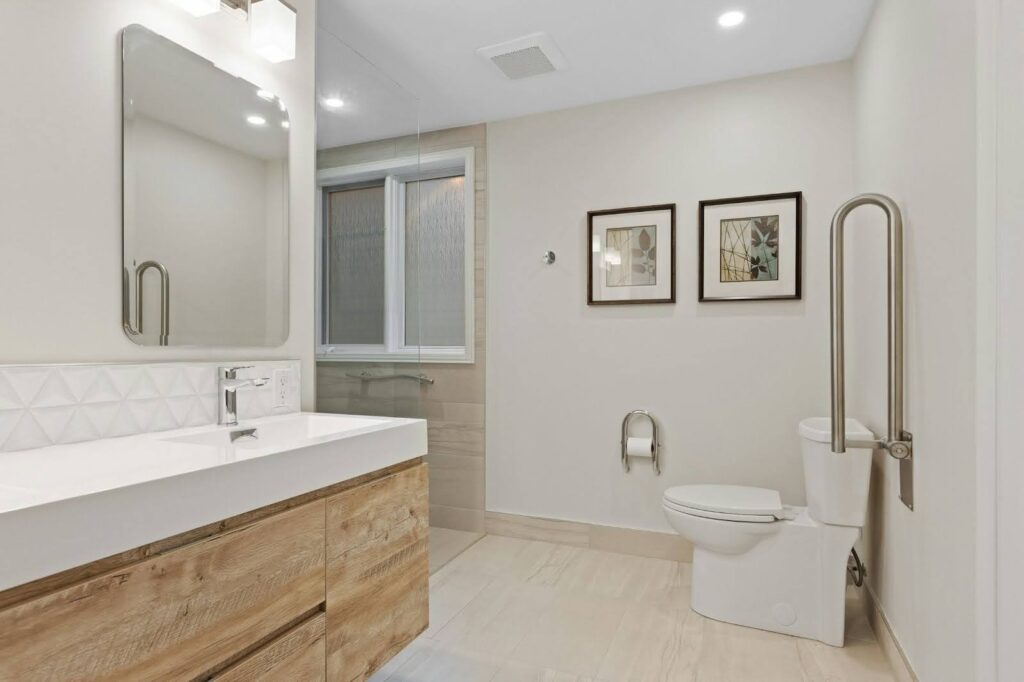The moment your elderly parent mentions struggling to step into the bath, or you notice them gripping the bathroom wall for support, it’s time to consider a crucial home modification. Walk-in showers and walk in baths represent more than simple bathroom upgrades-they’re essential safety investments that preserve dignity and independence for older family members.
These modifications aren’t just about accommodating current needs. They’re about creating a bathroom environment that adapts to changing mobility requirements whilst maintaining the comfort and privacy that everyone deserves in their own home.
How Walk-In Features Transform Bathroom Safety
Traditional bathtubs present significant hazards for seniors. The high step-over required to enter creates a dangerous barrier, particularly when combined with wet surfaces and limited grip options. Walk-in shower installations eliminate this primary risk factor entirely.
A properly designed walk in shower features level access or minimal threshold height, removing the need to lift legs high or balance on one foot. A walk in bath offers similar safety benefits whilst preserving the therapeutic experience of bathing. These units feature watertight doors that open inward or outward, allowing easy entry before filling with water. Built-in seating provides stability throughout the bathing process.
Independence Through Thoughtful Design
The psychological impact of bathroom accessibility cannot be understated. When seniors feel confident navigating their bathroom independently, it affects their entire quality of life. Walk-in shower systems restore this confidence through several key features:
Level access design allows those using walking frames or wheelchairs to move freely without assistance. Built-in seating provides rest options during longer washing routines. Hand-held shower heads accommodate various mobility levels and seated positions.
These features work together to create an environment where seniors can maintain their personal care routines without feeling vulnerable or dependent on others.
Supporting the Wider Family Circle
Bathroom modifications benefit more than just the primary user. Family members experience reduced anxiety knowing their loved ones can bathe safely. The constant worry about bathroom falls-particularly during unsupervised times-creates stress for everyone involved.
Walk-in shower installations also make assisted bathing easier when help becomes necessary. The open design allows carers to provide support without awkward positioning or safety concerns. This flexibility means families can adapt to changing care needs without further home modifications.
Choosing Between Walk-In Shower and Walk-In Bath Options
The decision between a walk-in shower and walk-in bath depends on individual preferences and mobility levels. Walk-in showers suit those who prefer quick, efficient bathing routines or have significant balance issues. They’re easier to maintain and typically cost less to install.
Walk-in baths appeal to seniors who find warm water immersion helpful for arthritis, circulation problems, or general relaxation. The therapeutic benefits of soaking can improve sleep quality and reduce joint pain-important factors for overall wellbeing.
For maximum accessibility, consider wet room conversions. These open-plan spaces eliminate all barriers, providing completely level access throughout. Wheelchair users benefit enormously from wet room designs, as do those requiring carer assistance.
Professional Installation Makes All the Difference
Proper installation is crucial for walk-in bathroom features. Waterproofing, drainage, and structural modifications require professional expertise. Attempting DIY installation risks water damage, safety hazards, and accessibility problems that defeat the original purpose.
Professional installers also ensure compliance with accessibility standards and building regulations. They can recommend the most suitable options based on individual needs, bathroom layout, and budget considerations.
Quality installation includes proper grab rail positioning, non-slip surfaces, and adequate lighting-details that significantly impact daily use and safety outcomes.
Creating a Bathroom That Adapts with Age
The bathroom should never become a source of fear or frustration for elderly family members. Walk-in showers and walk-in baths transform these essential spaces into areas of comfort and safety, supporting independent living for years to come.

